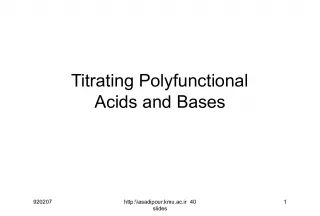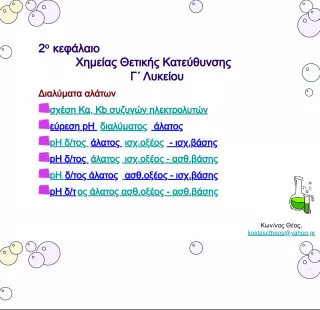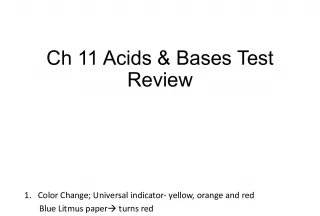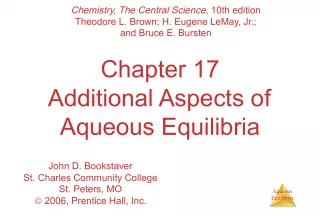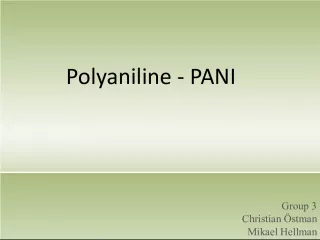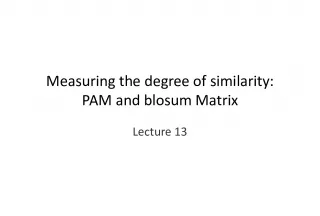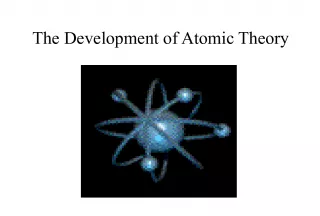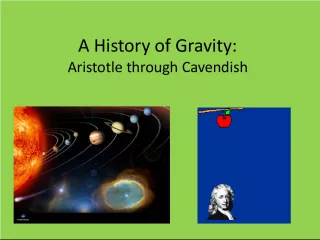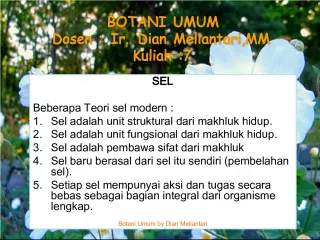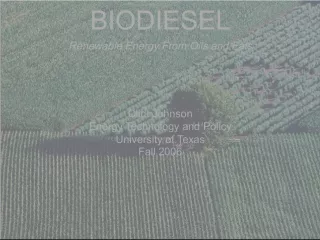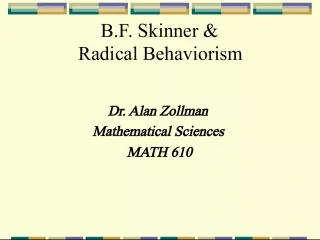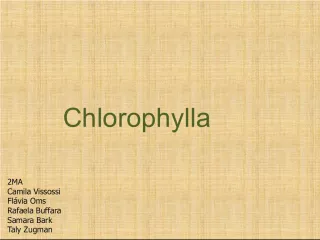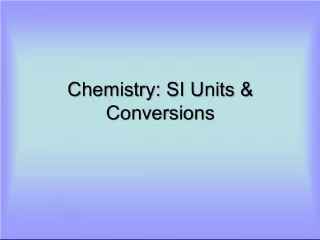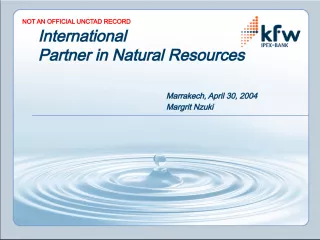Acid Base Theories


This chapter explores the properties of acids, bases, and salts. Acids taste sour, react with metals to produce H2, turn litmus red, and react with bases to form water and salt. Bases taste bitter, feel slippery, turn litmus blue, and become less basic when mixed with acids.
- Uploaded on | 1 Views
-
 atharv
atharv
About Acid Base Theories
PowerPoint presentation about 'Acid Base Theories'. This presentation describes the topic on This chapter explores the properties of acids, bases, and salts. Acids taste sour, react with metals to produce H2, turn litmus red, and react with bases to form water and salt. Bases taste bitter, feel slippery, turn litmus blue, and become less basic when mixed with acids.. The key topics included in this slideshow are . Download this presentation absolutely free.
Presentation Transcript
Slide1Acids, Bases and SaltsAcid-Base Theories CHAPTER 15 PA 530-538
Slide2What is an Acid?The term acid comes from the Latin term acere , which means " sour ". ex. Lemon juice, vinegar, and many other foods taste sour.
Slide3AcidsBases • Taste sour • Corrosive • React with some metals to produce H 2 • Change Litmus to red aci d = re d • React with bases to form water and salt. • Bases taste bitter • Feel slippery • Corrosive • Change Litmus to blue base = B lue • Become less basic when mixed with acids.
Slide4Always Use Ref. Tables (vinegar)
Slide5Table L Common Bases• Formula Name • Na OH (aq) sodium hydroxide • K OH (aq) potassium hydroxide • Ca( OH ) 2 (aq) calcium hydroxide • NH 3 (aq) aqueous ammonia
Slide6Svante Arrhenius 1859 - 1927Swedish chemist, proposed theories of electrolytic disassociation (acids/bases) and greenhouse effect.
Slide7Arrhenius Theoryof Acids & Bases Acid - produces hydrogen ion (H + ) in a solution. HA H + + A¯ Base – produces hydroxide ion (OH¯) in a solution. XOH X + + OH¯
Slide8Nature of the Hydrogen Ion orProton • Proton is so small that does not exist isolated in water. • H + + H 2 O H 3 O + • Hydronium Ion
Slide9Nature of Hydroxide Ion• The presence of OH - makes the substance an electrolyte and a base. • Alcohols contain the OH group but are NOT IONIC COMPOUNDS therefore alcohols are NOT bases. • C H O are molecular compounds NOT ionic compounds!!!!
Slide10HOW TO NAME ACIDS• NO OXYGEN IN FORMULA • HYDRO ----- ACID HCl Hydrochloric acid HBr Hydrobromic acid HF Hydrofluoric acid H 2 S Hydrosulfuric acid • OXOA CIDS • CONTAIN OXIGEN IN FORMULA • ENDING • OUS if ion ends ITE • IC if ion ends in ATE • Use table E
Slide11Solutions of Ionic Compoundsconduct electricity = Electrolytes Electrolytes – ions (charged particles) in solution. HCl (aq) H + + Cl - Hydrochloric Acid H + Cl -
Slide12Solutions; Release OH - (aq) Metal (+) and Non-Metal (-) Electrolytes – conduct electricity when dissolved in H 2 O
Slide13Solutions= Salts (ionic), acids, & bases Salts = ionic (+) (-) Strong Acid & Base Weak Acid or Weak Base Covalent = no ions bright dim dark
Slide14Conductivity apparatusElectrolytes – conduct electricity when dissolved in water
Slide15STRONG ACIDS• COMPLETELY DISSOCIATED • If the solution is 2 M, 2 mol of H + and 2 mol of Cl-
Slide16WEAK ACIDS• Partially dissociated. Molecules stay together and only some of them dissociate.
Slide17FHI F HBr F HCl F HNO 3 F H 2 SO 4 F HClO 4 G LiOH G NaOH G KOH G RbOH G CsOH
Slide18Naming Acids
Slide19Binary Acids- composed of hydrogen + 1 other element Ex. HCl Hydrochloric Acid Binary Acids begin with “ hydro -” followed by name of other element; modified with an ending of “- ic ”
Slide20Ternary Acids - molecular (covalent) - composed of hydrogen + oxygen containing polyatomic ion (Ref. E) Ex. HNO 3 Nitric Acid (NO 3 1- Nitrate ion) HNO 2 Nitrous Acid (NO 2 1- Nitrite ion) H 2 SO 4 Sulfuric Acid (SO 4 2- Sulfate ion) Ternary Acids = Anion suffix (-ate or -ite) is dropped and replaced with “- ic ” or “- ous ” respectively.
Slide21TABLE M common acids• H Cl(aq) hydrochloric acid • H NO 3 (aq) nitric acid • H 2 SO 4 (aq) sulfuric acid • H 3 PO 4 (aq) phosphoric acid • H 2 CO 3 (aq) carbonic acid • CH 3 COO H (aq) ethanoic acid • H C 2 H 3 O 2 (aq) (acetic acid)
Slide22Common Acids – Ref. KNitric acid (HNO 3 ) 1) Most is used to make fertilizer 2) Well known for making explosives Hydrochloric acid (HCl) 1) Most is used to clean metals (pickling) 2) Also called muriatic acid Sulfuric acid (H 2 SO 4 ) 1) The most widely used chemical in the world 2) Most of it is used to make fertilizer 3) It is a good dehydrating agent 4) It is used in car batteries
Slide24Properties of Bases1) Bases feel slippery 2) Bases are electrolytes 3) Bases are corrosive, poisonous, and can cause severe burns (Lye = conc. NaOH) 4) Bases turn litmus blue ; B lue = B ase 5) Bases = pH greater than 7 B ig in B ase 6) Bases neutralize acids
Slide25Common Bases – Ref. LAmmonia NH 3 1) The most widely used base 2) Used in household cleaning materials 3) Used as fertilizer; adds nitrogen to soil Calcium hydroxide (caustic lime) Ca(OH) 2 1) Used to make mortar and plaster 2) Used to help neutralize acid soil Sodium hydroxide (Lye) NaOH 1) One of the strongest bases 2) Used in oven cleaners and drain cleaners
Slide27Always Use Ref. Tables Acids ending = “- ic ” Bases = Metal + hydroxide (vinegar)
Slide28Reactions of Acid with metals• Use table J! • Metals above H 2 in table J react with acids by a single replacement reaction producing H 2. • 2 HCl + Zn H 2 + ZnCl 2
Slide29Neutralization ReactionAcids and bases react to neutralize each other, forming water and a salt: Acid + Base Water + Salt HA + XOH H 2 O + XA Double Replacement Reaction
Slide30Titration• Is a process that uses a neutralization to determine the concentration of an acid or a base. Concentration in molarity is the amount of moles of solute per liter of solution. When the reaction of neutralization is 1:1 we use the following formula in a titration • Ma x Va = Mb x V b
Slide31Vocabulary• Standard solution : the solution of known molarity • Buret : instrument to measure exact volumes of liquids • Erlenmeyer Flask • Indicator : a substance that changes color in the presence of an acid or base. • End point: when the amount of H + = OH -
Slide32At the end point• Ma x Va = Mb x V b
Slide33BaseOH - Acid H + Acid – Base Titration Erlenmeyer flask Two Burets with valves at bottom. Record vol. in mL (twice) Color indicator = phenolphthalein
Slide37What is pH ?pH is the negative logarithm of the hydrogen ion concentration = pH = - log [H + ] Remember that sometimes H + is written H 3 O + , so pH = - log [H 3 O + ] means the same thing.
Slide38pH Scale = log (base 10) scaleAn increase of 1 in pH corresponds to a decrease of a factor of 10 in H + concentration. pH is.. B ig in B ase & B lue
Slide39Typical pHValues of Common Materials Oven Cleaner / Drain Cleaner Hair Remover Baking Soda Soap Ammonia (NH 3 ) Lemon Juice Coffee / Tea Blood Battery Acid Saliva Pure Water Seawater Stomach Acid Milk Vinegar, Soft Drinks Tomatoes Basic Acidic Neutral
Slide40More about pHKw = dissociation constant for water = 10 -14 1 x 10 -14 = [H + ] x [OH - ] = [ 10 -7 ] x [ 10 -7 ] A neutral solution has a pH of 7. [H+] = [OH-] = 1 x 10 -7 M
Slide41pH and [H+ ] If pH is… [ H + ] = ?? pH = 8 _____ pH = 12 _____ pH = 6 _____ pH = 2 _____
Slide42Finding pH for a solution of a strongacid or strong base • For strong acid the concentration of the acid is the same as H + • For strong bases the concentration of the base is the same as OH - .
Slide43Find the pH for• A) 0.0001 M HCl • B) 0.01 M HBr • C) 0.001 M NaOH
Slide44Acid-Base Indicators• A substance that have different colors at different pH.
Slide46Always Use Ref. Tables (vinegar)
Slide47Bronsted Lowry definition• An ACID is a substance that donates H + • A BASE is a substance that ACCEPTS H +
Slide52P 177 REVIEW BOOK1) 2 2) 1 3) 1 4) 2 5) 4 6) 4 7) 1 8) 3 9) 2 10) 2 11) 4 12) 1 13) 1
Slide53P 181 Review Book17) 4 18) 1 19) 2 20) 4 21) 1 22) 4 23) 4 24) 1 25) 4 26) 4 35)4 27) 1 36)3 28) 4 29) 1 30) 4 31) 2 32) 3 33) 4 34) 1
Slide54P 185 answers40) 4 41) 2 42) 2 43) 1 44) 4 45) 2 46) 25 ml 47) 3000ml 48) 20mL 49) 50mL 50) 6M
Slide55P 178 rb answers• 14. chlorate • 15 a) hydrosulfuric acid • b) hydrobromic acid • c) lithium hydroxide • d) magnesium hydroxide • 16. An electrolyte can also be a base or a salt. An indicator can be added to test if is an acid or a base.
Slide56Page 187 answers61) 4 62) 1 63) 3 64) 3 65) 3 66) 2 67) 1 68) 1 69) 4 70) 2 71) Bromocresol green 72) Bet 5.4 and 6 73) A blue yellow 74) B 75) 1
Slide57Handout Answers1) 2 2) 2 3) 4 4) 2 5) 3 6) 3 7) 4 • pH=6 • Methyl orange/ Bromthymol blue • Bromocresol green
